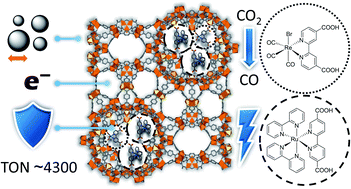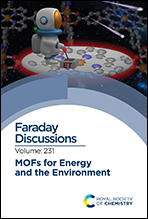Understanding entrapped molecular photosystem and metal–organic framework synergy for improved solar fuel production†
Abstract
Artificial photosystems assembled from molecular complexes, such as the photocatalyst fac-ReBr(CO)3(4,4′-dcbpy) (dcbpy = dicarboxy-2,2′-bipyridine) and the photosensitiser Ru(bpy)2(5,5′-dcbpy)Cl2 (bpy = 2,2′-bipyridine), are a wide-spread approach for solar fuel production. Recently metal–organic framework (MOF) entrapping of such complexes was demonstrated as a promising concept for catalyst stabilisation and reaction environment optimisation in colloidal-based CO2 reduction. Building on this strategy, here we examined the influence of MIL-101-NH2(Al) MOF particle size, the electron donor source, and the presence of an organic base on the photocatalytic CO2-to-CO reduction performance, and the differences to homogeneous systems. A linear relation between smaller scaffold particle size and higher photocatalytic activity, longer system lifetimes for benign electron donors, and increased turnover numbers (TONs) with certain additive organic bases, were determined. This enabled understanding of key molecular catalysis phenomena and synergies in the nanoreactor-like host–guest assembly, and yielded TONs of ∼4300 over 96 h of photocatalysis under optimised conditions, surpassing homogeneous TON values and lifetimes.

- This article is part of the themed collection: MOFs for energy and environmental applications


 Please wait while we load your content...
Please wait while we load your content...